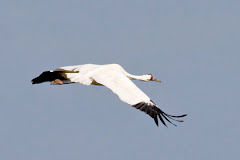
Well, it is that time again! Time for hunters to pack up their gear and head out to the woods, hoping to come home with a big buck.
Many of our supporters are hunters, or at least know hunters, and hunters have a great opportunity to help REGI during deer season! We know that the heart of the deer is usually left out in the woods along with the gut pile. REGI can use those hearts as a valuable, high nutrient, low-fat source of food for our raptors! We often purchase beef hearts for food, but the price is on the rise, and beef is not quite as lean and healthy as deer heart.
We can always use food donations, but this year it is even more vital that we have your help. We still have over 180 birds in care, more than 30 are eagles, and this is supposed to be our down season! With the closing of other facilities our patient numbers have greatly increased. Our facility is packed with owls, eagles, falcons, hawks, and other birds! Your deer heart could help to feed these amazing raptors.

(Photo above: An employee from Ken's Hwy 45 Meat Market in Antigo helps to load the REGI van with the boxes of deer hearts they collected in 2010.)
So, hunters, have a heart... for REGI!
Save your deer hearts in a plastic bag and drop them off at one of our collection sites around the state.
Collections will take place from November 19-27, 2011.
2011 Collection sites:
| Antigo | Ken's Hwy 45 Meat Market | N2220 US Highway 45, Antigo, WI |
| Appleton | Cedar Creek-Northland | 3220 E. Northland Ave Appleton, WI 54915 |
| Elderon | Mama's Place | Elderon, WI |
| Gillett | Northwoods Veterinary Center | 9920 State Hwy 22 E, Gillett, WI 54124 |
| Land O'Lakes | The Tackle Box | P.O. Box 989
4267 Hwy B
Land O' Lakes, WI 54540 |
| Marathon | P&K Machine | 203 2nd St., Marathon, WI 54448 |
| Milwaukee | Schlitz Audubon Nature Center | 1111 Brown Deer Rd., Milwaukee, WI 53217 |
| Park Falls | Faye Rogers | W8797 Hwy 70, Park Falls, WI |
| Rhinelander | YMCA of the Northwoods - Ministry Rehab | (Y) 2003 Winnebago St. (H) N9307 Mill Rd. Summit Lake, WI 54485 |
| Stevens Point | People's Meat Market | PO Box 659 6811 Burr Oak Rd, Stevens Point, WI 54481 |
| Stevens Point | Rusty's Backwater Saloon | 1715 W River Dr., Stevens Point, WI 54481 |
| Stevens Point | Renee's Red Rooster | 2339 County Road PS, Stevens Point, WI 54481 |
| Wallace, MI | Gary's Quality Foods | N5977 US Highway 41, Wallace, MI 49893 |
| Wausau | Zillman's Meat Market | 1910 6th St., Wausau, WI 54403 |
| Wausau | Wild Birds Unlimited | 4121 Rib Mountain Dr., Wausau, WI 54401 |
| Weston | Country Fresh Meats | 9902 Weston Ave., Weston, WI 54476 |
If you do not see a collection site in your area feel free to collect them on your own, or start a site locally. Please, spread the word to as many hunters as possible! With your help this can be a great success. You can find more information about the program on the REGI website at
www.raptoreducationgroup.org.
If you have venison left in your freezer from last year we would happily take that off of your hands for you as well. As long as the meat is not severely freezer burnt we can use it.
Another important and simple thing that hunters can do is to switch to non-lead ammunition. If you are following our blog you surely know about the dangers of lead poisoning, we currently have 5 lead poisoned Bald Eagles being treated in our clinic. Watch this
news clip from WJFW about some of the patients that arrived in the clinic just a few weeks ago.
If you are having a hard time finding lead alternative ammunition you can check out
this list from the Wisconsin Department of Natural Resources. Or if you would like to learn more about the effects of lead on wild birds read
this report from the USGS Wildlife Health Center. And of course we are always happy to talk with people about responsible hunting.
Just remember, don't leave your deer hearts in the woods this year, have a heart for REGI instead!
Happy hunting!
Molly McKay
Director of Education
If you have any questions regarding the Have-A-Heart program, or would like to start your own location call (715)623-2563 or email MollyM.REGI@gmail.com.














